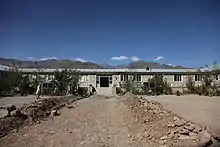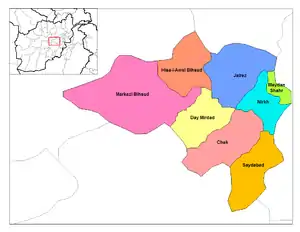Maidan Wardak Province
Maidan Wardak or Maidan[4] (Pashto: میدان وردګ), also called Wardag or Wardak, is one of the 34 provinces of Afghanistan, located in the central region of Afghanistan. It is divided into eight districts and has a population of approximately 500,000.[5][3] The capital of the province is Maidan Shar, while the most populous district in the province is Saydabad District. Wardak is known for one of its famous high peak mountain known as (Shah Foladi).
Maidan Wardak
میدان وردګ | |
|---|---|
 A settlement in Maidan Wardak along the road between Kabul and Bamiyan | |
 Map of Afghanistan with Wardak highlighted | |
| Coordinates (Capital): 34.4°N 68.4°E | |
| Country | |
| Capital | Maidan Shar |
| Government | |
| • Governor | Muhammad Amin Jan[1] |
| • Deputy Governor | Sher Ahmad Ammar[1] |
| • Police Chief | Sheikh Mohammad Sharif Halimi[2] |
| Area | |
| • Total | 10,348 km2 (3,995 sq mi) |
| • Land | 10,348 km2 (3,995 sq mi) |
| • Water | 0 km2 (0 sq mi) |
| Population (2021)[3] | |
| • Total | 671,817 |
| • Density | 65/km2 (170/sq mi) |
| Time zone | UTC+4:30 (Afghanistan Time) |
| ISO 3166 code | AF-WAR |
| Main languages | Pashto Hazaragi and Dari |
In 2021, the Taliban gained control of the province during the 2021 Taliban offensive.
History
| History of Afghanistan |
|---|
 |
| Timeline |
|
During the communist times, the people of Maidan Wardak never gave significant support to the communist government.[6] Wardak Province was significant during the Civil War in Afghanistan, due to its proximity with Kabul and its agricultural lands. Hezb-e Wahdat had a significant presence in the area. Most of the area was captured by the Taliban around winter 1995.[6] It remains a major Taliban travel route to Kabul with Maidan Shar a target for terror.
The security situation rapidly deteriorated in Wardak in 2008 and 2009. According to a report by Mohammad Osman Tariq Elias, both Logar and Wardak, by the end of 2008, were under de facto Taliban control.[6] As of April 2009, the Ministry of the Interior (Afghanistan) had listed the entire province as "High Risk."[7]
In October 2017, US Forces from elements of the 1st Battalion 87th Infantry Regiment and 10th Special Operations Group launched an offensive to wrest the province from Taliban control.
On 21 January 2019, a Taliban attack on a military base and police training center in the province resulted in 125 NDS officers killed. At least 30 people were reported to be injured. The attack came during a time of intense daily violence throughout the country.[8]

Geography

Maidan Wardak province is located in the central and eastern region of Afghanistan; bordering Parwan to the northeast, Kabul and Logar to the east, Ghazni to the south and Bamyan to the west. The capital of Wardak province is Maidan Shar, which is located about 35 km from Kabul. Wardak province covers an area of 9,934 km2. It is mountainous like the rest of the country with plains and many valleys, such as the Tangi Valley. The majority of its residents live in rural areas. The most heavily populated areas are along the Kabul–Kandahar Highway. The rest of the province is thinly populated, with villages concentrated in areas with available irrigation and water sources (CSO and UNFPA, 2003). Famous passes include the Unai Pass and the Hajigak Pass.
Economics and industry
In terms of industry, one marble factory is working in the province, and there are marble mines in the provincial center and Sayed Abad District although no mining is currently undertaken there due to the government ban. The majority of commercial activity in Maidan Shahr. Wardak is related to trade in agricultural and livestock products, although stone quarrying is also a growing business in the area. The people from Maidan Shahr are also experts in karez cleaning and repair and go to other parts of the country for this purpose. In Wardak, there are many natural resources like petroleum, iron, rubies, and emeralds.
Agriculture is a major source of revenue for 43% of households in Maidan Wardak province. Four-fifths (79%) of rural households own or manage agricultural land or garden plots in the province. However, nearly a quarter (24%) of households in the province derive income from trade and services, and around half (45%) of households earn some income through non-farm related labor.
Education

The overall literacy rate in Maidan Wardak province is 25%. There are around 251 primary and secondary schools in the province catering for 105,358 students. There are 2909 teachers teaching in these schools.[9]
Demographics

As of 2021, the total population of Maidan Wardak province is about 671,817.[3] The province is predominantly Pashtun and Hazaras with Tajiks making up most of the remainder of the population. The Tajiks live primarily in northern districts of the province while the Hazaras live in the western part of the province. The province also has a small population of Qizilbash.[10][11]
Districts
| District | Capital | Population[3] | Area[12] | Notes |
|---|---|---|---|---|
| Chaki Wardak | Chaki Wardak | 97,059 | 1,273 | |
| Day Mirdad | Miran | 35,687 | ||
| Hisa-I-Awali Bihsud | 42,582 | |||
| Jaghatu | 52,585 | Shifted from Ghazni Province in 2005 | ||
| Jalrez | 60,966 | |||
| Markazi Bihsud | Behsud | 137,208 | ||
| Maidan Shar | Maidan Shar | 46,611 | ||
| Nirkh | 65,562 | |||
| Saydabad | Saydabad | 133,573 | 1,163 |
References
- "د نږدې شلو ولایاتو لپاره نوي والیان او امنیې قوماندانان وټاکل شول". 7 November 2021.
- "د میدان وردګو ولایت لپاره نوی ټاکل شوی والي د کورنیو چارو وزارت د اداري مرستیال او کفیل له لوري د ولایت کارکوونکو ته ور وپېژندل شو. | د کورنیو چارو وزارت". moi.gov.af.
- "Estimated Population of Afghanistan 2021-22" (PDF). National Statistic and Information Authority (NSIA). April 2021. Archived (PDF) from the original on June 24, 2021. Retrieved June 21, 2021.
- "Wardak". Office of the President of Afghanistan.
- "Maydan Wardak - Program for Culture and Conflict Studies - Naval Postgraduate School".
- Elias, Mohammed Osman Tariq (2009). "The Resurgence of the Taliban in Kabul, Logar and Wardak". In Giustozzi, Antonio (ed.). Decoding the New Taliban: Insights from the Afghan Field. Hurst & Company. ISBN 978-1-85065-961-7.
- British Broadcasting Corporation. Afghanistan: Security Map. 19 August 2009. Accessed at: http://news.bbc.co.uk/2/hi/south_asia/8194230.stm Accessed on [28 September 2009]
- Taliban Attack on Afghan Military Base and Police Training Center Kills 12 21 January 2019. Accessed at: Accessed on [21 January 2019]
- "Ministry of Rural Rehabilitation and Development" (PDF). Mrrd.gov.af. 2012-08-04. Retrieved 2012-08-15.
- "Maydan Wardak Province". Understanding War. Retrieved 2013-09-25.
- "Mayden Wardak Provincial Overview". Program for Culture & Conflict Studies. Naval Postgraduate School. Retrieved 24 June 2021.
- "FAO in Afghanistan | Food and Agriculture Organization of the United Nations". www.fao.org.